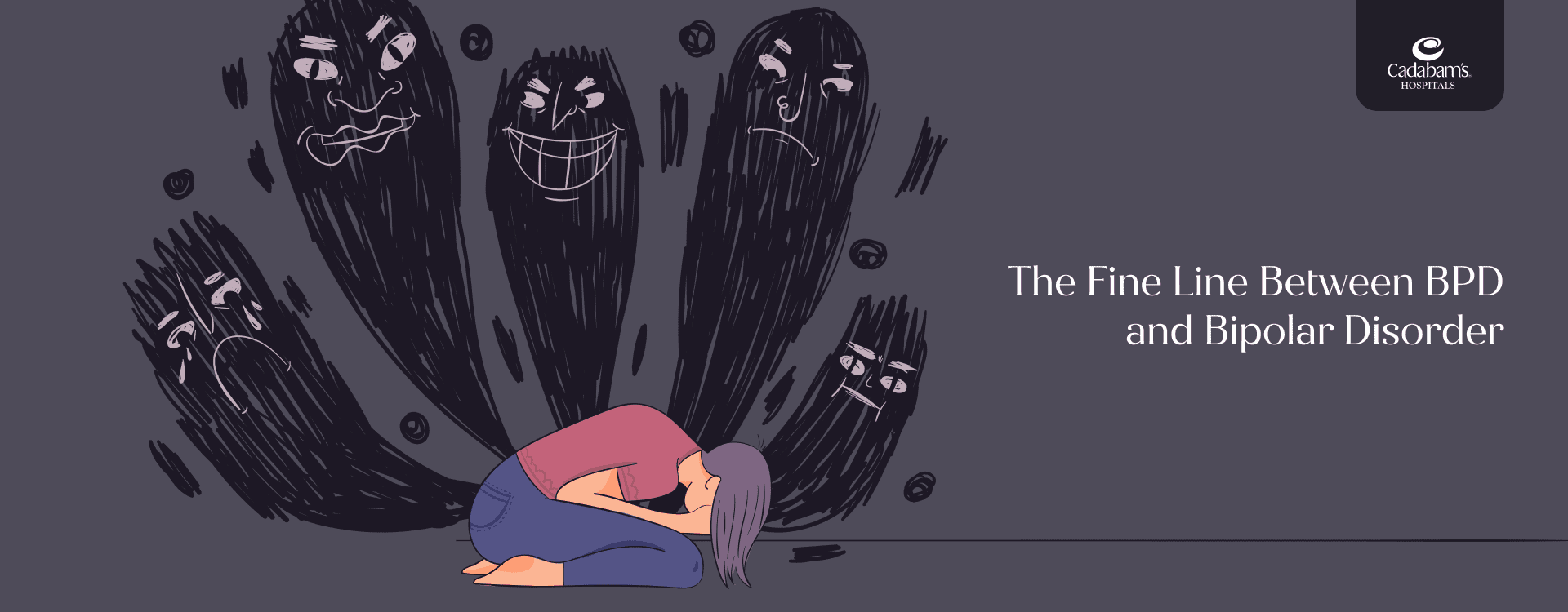Table of Content
Understanding the Overlap Between Bipolar Disorder and BPD
Both bipolar disorder (BD) and borderline personality disorder (BPD) may sound similar and have overlapping symptoms; however, these conditions are totally different. According to several studies, close to 2.4% percentage of the worldwide population has bipolar disorder, and approximately 0.7% to 2.7% of the general population has borderline personality disorder Both these conditions can cause emotional distress, but they differ in keyways. Let's explore areas of overlap:
Mood Fluctuations
While both experience mood swings, bipolar disorder has distinct manic and depressive episodes. BPD's mood shifts are more frequent and reactive to events.
Impulsive Actions
Both conditions can lead to impulsive behaviors. In bipolar disorder, impulsivity might be fueled by mania, while BPD's impulsivity is linked to emotional dysregulation.
Substance Abuse
Self-medication is common for both disorders. People with bipolar disorder might misuse substances to manage mood swings, while those with BPD might use them to cope with emotional pain.
Early Warning Signs of Bipolar Disorder and BPD
Bipolar disorder shows early signs such as extreme mood swings, changes in energy levels, difficulty concentrating and impulsive behaviour. In borderline personality disorder (BPD), early signs include intense emotional reactions, fear of abandonment, unstable relationships and identity issues. Recognising these patterns early can lead to timely intervention and better management of these disorders.
Causes of Bipolar Disorder
Genetics and brain chemistry are likely culprits in bipolar disorder, though environmental factors may play a role.
Causes of Borderline Personality Disorder
A combination of genetics, brain development, and environmental factors, including childhood trauma, are believed to contribute to BPD.
Impact of Each Disorder on Daily Functioning and Relationships
Condition like bipolar disorder can make it difficult to maintain stability and productivity in daily life due to its frequent mood swings. Relationships can struggle due to erratic behaviour or withdrawal. Borderline personality disorder interferes with daily life through intense emotions, impulsivity and identity issues, often leading to strained relationships. Both require understanding and support for better coping and bonding.
Misconceptions and Myths About Bipolar Disorder and BPD
Common myths about the bipolar disorder include considering it as mere mood swings or even equating it to personality disorders. Many believe it is untreatable, ignoring how therapy and medications can be useful in treating it.
Myths about borderline personality disorder (BPD) include labelling individuals as manipulative or 'difficult',” overlooking the emotional distress behind their behaviours.
Both disorders are often stigmatised as people assuming they define a person’s character rather than being a mental illness. Awareness and understanding are key to breaking down these stereotypes.
Bipolar vs BPD Test: Understanding the Diagnostic Process
There's no single test for bipolar disorder (BD) or borderline personality disorder (BPD). A mental health professional uses a multi-step approach:
Importance of Accurate Diagnosis
Getting the right diagnosis ensures you receive the most effective treatment plan for managing your symptoms and improving your quality of life.
Common Tests and Assessments
Clinical interviews, psychological testing, and mood-tracking tools help assess symptoms and rule out other conditions.
Distinguishing Mood Change Characteristics
Mania in bipolar disorder involves racing thoughts, while BPD mood shifts are more reactive and fleeting.
Duration of Mood Fluctuations
Bipolar episodes last days or weeks, while BPD's mood swings are shorter and often triggered by events.
Triggers for Mood Shifts
Bipolar mood changes aren't necessarily triggered by events but can occur seemingly out of the blue. BPD's mood shifts, on the other hand, often stem from interpersonal conflicts, real or perceived threats of abandonment, or other stressful situations.
Intensity and Nature of Mood Shifts
Bipolar episodes involve extreme highs (mania) and lows (depression), while BPD mood shifts are intense but not as extreme.
Treatment Options in BPD and Bipolar
While both bipolar disorder and BPD can cause emotional distress, the treatments differ. Unlike bipolar's elation, BPD mood shifts go from distress to neutral, not euphoria.
Treatment for Bipolar
Medication
Mood stabilizers and antipsychotics are the primary medications used to regulate mood swings.
Psychotherapy
Individual therapy can help manage symptoms and develop coping mechanisms.
Lifestyle Modifications
Regular sleep, a healthy diet, and stress management techniques are crucial.
Support Groups
Connecting with others who understand bipolar disorder can be invaluable.
Treatment for Borderline Personality Disorder (BPD)
Dialectical Behavior Therapy (DBT)
Teaches skills for managing emotions, reducing self-destructive behaviors, and improving relationships.
Cognitive Behavioral Therapy (CBT)
It helps identify negative thought patterns and develop healthier coping mechanisms.
Medication
Medications like antidepressants may be used to address specific symptoms like anxiety or depression that often accompany BPD.
Schema Therapy
Identifies core emotional patterns and helps develop healthier ways to respond to situations.
Treatment Outcomes for Dual Diagnosis: Bipolar Disorder and Borderline Personality Disorder
Mood Stabilization
Effective treatment can significantly reduce mood swings, preventing episodes of mania, depression, or hypomania. This allows individuals to experience a more balanced emotional state and improve their overall well-being.
Improved Emotional Regulation
Individuals learn to identify and manage emotional triggers, developing healthier coping mechanisms for emotional distress. This can include techniques like mindfulness, relaxation exercises, and distress tolerance skills.
Strengthened Interpersonal Skills
Therapy can improve communication, build healthier relationship patterns, and foster better conflict-resolution skills. This can lead to more supportive and fulfilling relationships in all aspects of life.
Medication Management
A psychiatrist can recommend medications to regulate mood swings and improve overall functioning. These medications may target bipolar disorder symptoms or co-occurring conditions like anxiety or depression.
Crisis Management
Developing a plan to identify and respond to crisis situations can promote safety and well-being. This plan might involve creating a support network, identifying warning signs of crisis, and having coping strategies in place.
Improved Daily Functioning
Treatment can empower individuals to manage symptoms, engage in daily activities, and achieve personal goals. This can include improvements in work performance, social interactions, and overall quality of life.
Prevention Strategies for Managing Bipolar Disorder and BPD
While these disorders can't be prevented, early intervention and self-management can significantly improve quality of life. Here are some key strategies:
- Follow treatment plans: A mental health professional can create a plan to manage your specific condition.
- Avoid substances: Drugs and alcohol can worsen symptoms.
- Identify triggers: Recognize events or situations that lead to mood swings and develop coping mechanisms.
- Healthy lifestyle: Eat nutritious foods, get enough sleep, and exercise regularly.
- Stress management: Techniques like yoga or meditation can promote emotional well-being and effectively manage stress.
- Regular routine: Create a consistent sleep schedule, meal times, and exercise routine for stability.
Supporting a Loved One with Bipolar Disorder or BPD: Effective Strategies
- Gain Knowledge on Their Condition: Educate yourself about symptoms and treatment options. Understanding their experience fosters empathy and better support.
- Practice Non-Judgment: Offer unwavering support and understanding. Avoid criticism during emotional episodes.
- Cultivate Patience: Recovery is a journey with ups and downs. Be patient and supportive throughout the process.
- Regular Wellness Checks: Encourage healthy habits like sleep, diet, and exercise. Monitor their well-being and offer help when needed.
- Promote Professional Mental Health Care: Support them in seeking professional help from therapists or psychiatrists.
Path to Wellness: Effective Bipolar and BPD Care with Cadabams
Living with bipolar disorder or BPD can be challenging, but you don't have to navigate it alone. At Cadabams, we understand these conditions and offer a comprehensive approach to care. Our team of specialists can create a personalized treatment plan to manage symptoms and improve your quality of life.
If you are searching for a solution to your problem, Cadabam’s Hospitals can help you with its team of specialized experts. We have been helping thousands of people live healthier and happier lives for 30+ years. We leverage evidence-based approaches and holistic treatment methods to help individuals effectively manage bipolar disorder and borderline personality disorder. Get in touch with us today. You can call us at +91 97414 76476. You can even email us at info@cadabamshospitals.com.
FAQ
1. What are the main differences between Bipolar Disorder and BPD?
While both involve mood swings, bipolar disorder causes distinct manic and depressive episodes, while BPD has emotional instability with rapidly shifting moods. Bipolar disorder affects energy and activity levels, while BPD focuses on self-image and relationships.
2. Can Bipolar Disorder and BPD coexist in one individual?
Yes, it's possible to have both bipolar disorder and BPD. This can make diagnosis and treatment more complex. A mental health professional can accurately assess symptoms and create a comprehensive treatment plan.
3. How are Bipolar Disorder and BPD diagnosed?
There's no single test for either disorder. Diagnosis typically involves a mental health evaluation, including discussions about symptoms, personal and family history, and psychological testing.
4. What treatment options are available for Bipolar Disorder and BPD?
Treatment for both often involves a combination of medication and therapy. Medications can help regulate mood swings in bipolar disorder. Therapy, such as psychotherapy or dialectical behavior therapy (DBT), can help manage symptoms in both conditions.
5. Is recovery from Bipolar Disorder or BPD possible?
There's no cure for either disorder, but effective treatment can significantly improve quality of life. With treatment, individuals can learn to manage symptoms, build healthy coping mechanisms, and live fulfilling lives.
6. Is Borderline Personality Disorder bipolar?
No, Borderline Personality Disorder (BPD) and bipolar disorder are different conditions. BPD involves emotional instability, fear of abandonment, and relationship difficulties, while bipolar disorder features mood swings between mania and depression.
7. Can BPD cause mania?
BPD doesn't directly cause mania, a hallmark of bipolar disorder. However, intense emotional shifts in BPD might sometimes resemble manic symptoms, but they are typically shorter and triggered by interpersonal situations.
8. Is Borderline Personality Disorder more common than bipolar disorder?
Borderline personality disorder can be less common than bipolar disorder according to several studies. BPD affects 0.7% to 2.7%, while bipolar disorder affects 2.4% of the global population.
How Cadabam's Help you for Addiction?
- 410+ Professional Consultants
- 1,00,00+ Happy Faces
- 120+ Currently Seeking Treatments





